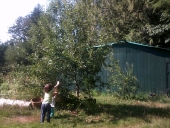
 5
5





 2
2




List of Bryant RedHawk's Epic Soil Series Threads We love visitors, that's why we live in a secluded cabin deep in the woods. "Buzzard's Roost (Asnikiye Heca) Farm." Promoting permaculture to save our planet.
 1
1




















List of Bryant RedHawk's Epic Soil Series Threads We love visitors, that's why we live in a secluded cabin deep in the woods. "Buzzard's Roost (Asnikiye Heca) Farm." Promoting permaculture to save our planet.




























List of Bryant RedHawk's Epic Soil Series Threads We love visitors, that's why we live in a secluded cabin deep in the woods. "Buzzard's Roost (Asnikiye Heca) Farm." Promoting permaculture to save our planet.
 1
1








William Sharek wrote:It is good to know that others have troubles growing fruit. Every year I plant at least 1 semidwarf fruit tree. The Fuji apple and the Jonathan apple (one each) that I planted 12 years ago finally had fruit, although only a dozen apples each, this summer. We also have one each of Red Delicious, Yellow, Macintosh, Honey Crisp, Gala, Winesap and Granny Smith. For my wife, I planted an equal number of cherry trees ....also one each of Black Tartan, Royal Ann, Bing, Van, Lambert, Jubilee (2), Hudson and White Gold. Like the apple trees, I started 12 years ago and only the Bing and the Jubilee are bearing fruit (the oldest). We also have four pear trees, planted in 2006, which are knobby-looking trees (not smooth bark) and produce only 3-4 pears each. I am grateful to the person who posted the old adage "pears are for your heirs". They are healthy trees but obviously will produce in time for my grandson to pick them. I guess the point is that you have to plant fruit trees, not because you want a lot of fruit, but because you are a dreamer who wants to dream that your kids and grandkids will be the one to benefit sometime in the future. By the way, this was the first year that my grandson (age 6) climbed the oldest cherry tree which I planted in 2005 or 2006. By the way, this was the first year that I planted two Paw Paws, a.k.a. the northern banana. Part of our land (we own about 1.3 acres) gets very wet due to the slope of the land and everything planted there was dying. I was told that the Paw Paw likes bog-like soil so we are hoping that we get this fruit. Unfortunately, they say that this tree requires 10-15 years so I guess my grandson will enjoy this fruit when I am probably in my wheelchair.
 1
1





| I agree. Here's the link: http://stoves2.com |








